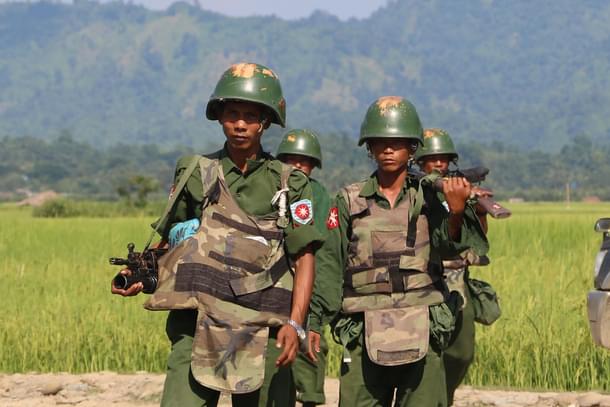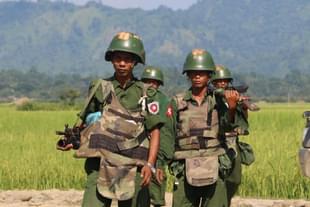World
In A Strategic Victory For India, Myanmar Starts Flushing Out North East Militants
Jaideep Mazumdar
Feb 19, 2019, 01:12 PM | Updated 01:12 PM IST
Save & read from anywhere!
Bookmark stories for easy access on any device or the Swarajya app.


In what can be termed a major diplomatic victory for the Narendra Modi government, Myanmar has acceded to New Delhi’s urging to deny use of its soil for anti-India activities by militant groups of North East India. Myanmar Army (called the ‘Tatmadaw’) took over the headquarters of Naga rebels in the Ta Ga area of Sagaing region last month-end and has asked all non-Myanmarese insurgents to move out of its territory.
According to senior officers at the Indian Army’s Eastern Command headquarters in Kolkata, the Tatmadaw entered and took control of the headquarters of the proscribed Khaplang faction of the National Socialist Council of Nagaland (NSCN-K) at Ta Ga on 29 January.
More than 400 Tatmadaw soldiers led by Hkamti District (under the army’s north-west command) tactical commander equipped with assault rifles and mortars overran the NSCN-K headquarters, disarmed the NSCN-K cadres present there and expelled all the rebels. As of now, only a handful unarmed cadres of the Naga rebel outfit remain at that camp.
The Tatmadaw, according to a communique from its commander-in-chief issued last week, also took over three outposts and dismantled two training camps set by Manipur and Assam insurgent outfits. The Myanmarese army has told these outfits in unequivocal terms that they have to leave Myanmar immediately and if they remain, they will be considered hostiles.
The Paresh Barua-led United Liberation Front of Asom (Independent), Manipur’s People’s Liberation Army (PLA), United National Liberation Front (UNLF), People’s Revolutionary Party of Kangleipak (Prepak) and some other outfits in the region had taken shelter and set up training facilities in Myanmar adjoining Nagaland, Manipur and Mizoram.
It must be noted here that the NSCN(K) is considered by Myanmar to be a local (Myanmarese) rebel outfit since most of the cadres are Myanmarese Nagas and the outfit was formed by Khaplang, who was from an ethnic Naga tribe of Myanmar. The stated objective of the NSCN(K), as well as the other NSCN faction whose cadres are mostly made up by Indian Nagas — the NSCN(IM) — is integration of all Naga-inhabited areas of India and Myanmar into a separate country. The NSCN(K) has been in an informal ceasefire with the Tatmadaw since 2001 and this arrangement was formalised in April 2012 at Hkamti in Myanmar.
The NSCN(K) had also entered into a ceasefire agreement with the Indian government, but unilaterally abrogated it in 2015 and shifted its cadres to Myanmar. Since then, it has provided refuge and other facilities, including training, to other outfits of northeast India in return for large sums of money. The leaders of the ULFA(I) and Manipuri outfits also allow their cadres to be used as ‘mues’ to transport drugs from Myanmar to India as a form of payment to the NSCN(K). The NSCN(K) controls the illicit drug trade in north-western Myanmar.
Nine rebel outfits of the North East, including the ULFA(I), the Manipuri groups and NSCN(K), had formed the ‘United National Liberation Front of West South East Asia’ and had carried out joint operations against Indian security forces. The most deadly attack was the one on an Indian Army convoy in Manipur in July 2018 that left 18 soldiers dead. After the attack, Indian Army’s Special Forces carried out surgical strikes on rebels’ camps in Myanmar, destroyed three sch camps and killed an unspecified number of rebels.
The Tatmadaw has accused the NSCN(K) of breaching the 2012 ceasefire agreement by sheltering leaders and cadres of other rebel outfits of North East India. According to some reports, the Tatmadaw has arrested six NSCN(K) armed cadres and two ULFA(I) and PLA rebels. This action by the Myanmarese army comes after sustained pressure by New Delhi on Myanmar to act against these rebels. ULFA(I) chief Paresh Barua has himself accused Myanmar of bowing to pressure from India.
Myanmar has also rejected a plea by the ULFA(I) and the Manipuri insurgent groups to allow them to set up camps in Myanmar. The Myanmarese military authorities have told the rebels to shift out of that country and has reportedly granted them time until mid-March to do so. According to central intelligence agencies, there are around 2,000 armed cadres of North East India-based insurgent outfits, including 150 of the ULFA(I) and 100 of the Songbijit faction of the National Democratic Front of Bodoland (NDFB) in Myanmar.
Anticipating the return of these insurgents to India, the Indian Army has stepped up vigil along the Indo-Myanmar border. The Tatmadaw is also setting up a permanent base in Ta Ga to keep a watch on NSCN(K) cadres and evict cadres of other rebel outfits from the region. India has provided training in counter-insurgency and jungle warfare to the Tatmadaw and also provided arms, ammunition and other military hardware to it. This capacity-building has been done with the objective of equipping the Tatmadaw to counter the rebels of North East India sheltered in that country.
The Tatmadaw has also, for the first time, launched long-range patrols on its side of the border with India to trap rebels of the North East militant outfits and to cut off supplies to them. Ta Ga is about seven days’ trek through thick jungles from India and Indian army intelligence says that many rebels are slowly moving towards the international border.
“They are desperate to cross over to India, but all the jungle routes they have been using have been blocked,” said a top army officer. The free movement of villagers residing in the settlements along both sides of the border has also been severely restricted by the forces of both the countries.
It is now a ‘wait and watch’ game for the Indian security forces stationed along the India-Myanmar border. “The Myanmarese army is keeping up the pressure on the rebels and we expect it is a matter of time before the desperate rebels try to sneak in to our side. We are waiting for them,” said the army officer. If that happens, it will deal a body blow to the remnants of insurgency in North East India. And this represents a major victory for the Narendra Modi government.
Strategic affairs experts point out that with insurgency being erased from the North East, the ‘Act East’ vision of the Modi government will get a massive boost with the establishment of communication and trade links between North East India and South East Asia as well as China through Myanmar picking up the much-required pace.





